COMPUTERS: WHO-WHEN-HOW? - PART 1: HISTORY
How computers were made and who did it?
PLEASE STOP!
Stare and think:
How is it even possible for me to do all these things?
Who should I thank?
How is this supposed to work?
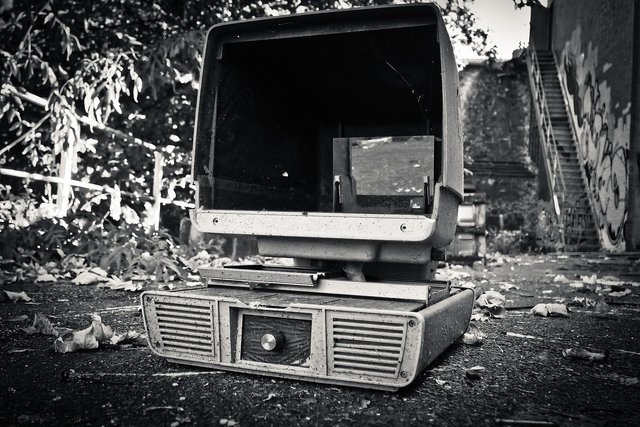
Nostalgic snap of an old Personal Computer 🖳
In this post, we'll discuss how science made us able to access, create and share new content every day on the web. We will explore the history of the computer and computer science too.
ARE YOU READY FOR A NEW JOURNEY WITH ME?
Preface
The history of computer can't be illustrated completely because it has its roots in the first human counting instruments, furthermore, there isn't a unique inventor for such a complex machine, but rather the entire human kind may be considered as such.
Do you really know what a computer is?
A computer is everything that can "compute" or help doing that, so the first computer was probably a dinosaur that could count from 1 to 5...
But wait! Not only dinosaurs can count, even humans can! So we could be considered computers too.
If we are computers, you won't be too surprised that some old tools were as well.
They aren't different, for definition, from an i9-9900K: all computers are all tools, they compute what humans (or intelligent life) tell them to compute; even AI (Artificial Intelligence) isn't genuine thinking.
At this point, you may ask yourself what's the difference between our way of thinking and the computer's one; for me, machines don't think at all, they just do a lot of calculations... But that's modern philosophy. Now, let's start!
Let's tell the (hi)story...
Once upon a time, a guy who had to do some math, decided to craft the first calculator that the world has ever seen: it was a kind of stick... a "tally stick".
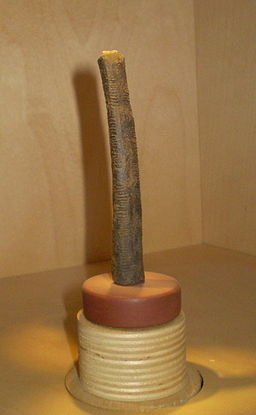
The Ishango Bone...
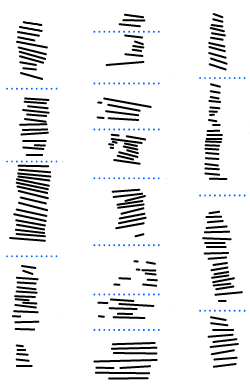
... and its "tally marks"
It was a very simple tool, it was used to write down natural numbers and then make summations and (maybe) multiplications. It was a supercomputer of 20000 BC and it used to run at (about) 9999999.9 GHz.
More than 19000 years later, in Ancient Greece, an unknown genius created a clock, a super clock!
It was able to calculate sunrises, lunar phases, movements of planets, equinoxes, eclipses, days, months, etc. and dates of the Olympic Games.
It is one of the most impressive Analog Computers of all times and today we call it "The Antikythera Mechanism".
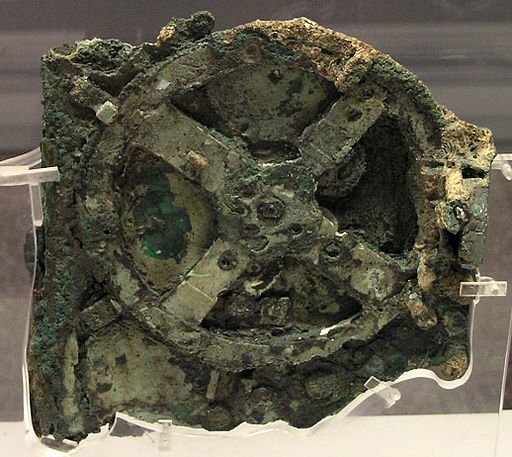
The Antikythera Mechanism
It was so complex that took the professor Derek de Solla Price 20 years to unveil the original mechanism and only in 2016 a team of scientists, by X-Rays, confirmed the purpose of the machine.

Antikythera Mechanism Computer Animation
In the 19th century, there was a man who was fed up of calculating by hand so he invented the first general-purpose computing device! He was mathematician called Charles Babbage and his invention wasn't easy to build at all because of the various problems he had to deal with. He created two versions of his machine: the Difference Engine and the Analytical Engine, the most important is the second one.
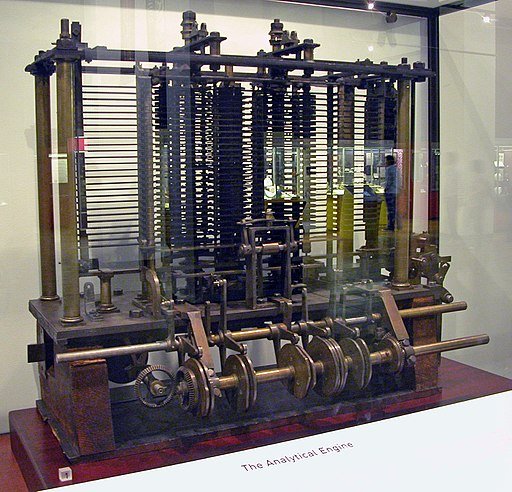
The Analytical Engine
In 1936, the mathematician Alan Turing (you probably know him because of "The Imitation Game") published "On Computable Numbers, with an Application to the Entscheidungsproblem", it is a paper where he defines in mathematical terms a class of computational devices that will be known as "Turing Machines" and in particular the "Universal Turing Machines", these machines are theoretically capable of performing any mathematical calculation if an algorithm is provided, moreover he demonstrated that the Entscheidungsproblem (a logic problem, also know as the "decision problem") is impossible to solve; he just created the theoretical computer science and the concept of AI (artificial intelligence).
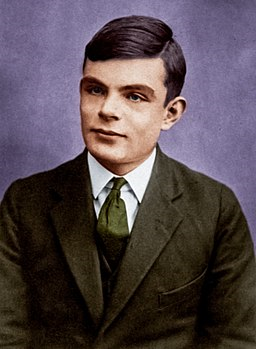
A colorful Alan Turing
The cryptologic war
Finally, during WWII, the first digital computers were born.
Most of them were created to fight Nazism and the first ones were called "bombs" 💣, although thery're not explosive, they had the purpose of decoding ENIGMA machine messages, the first bomb was Polish and it was called "Bomba", it was designed by Marian Rejewski, then the British Alan Turing improved it and created his own "Bombe", in the end, Americans developed faster versions of the British Bombe.
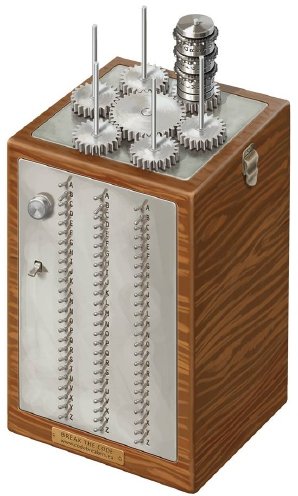
A Computer-made recreation of a Polish Bomba 💣
Many of these bombs still exist, except for the Polish Bomba machines, they were all destroyed during Nazi occupation of Poland; during wartime, there were so many machines because of the continuous improvement of the ENIGMA machine, in fact, there were several versions.
The world's first programmable, electronic, digital computer was "Colossus", it was manufactured in order to decrypt the Lorentz Cipher.

Colossus Control Panel

Colossus in Bletchley Park
Although Colossus was programmable, it wasn't a general purpose machine. The first machine that was both electronic and general purpose was ENIAC.
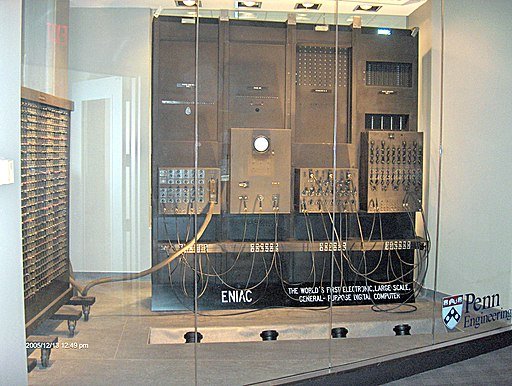
ENIAC (Electronic Numerical Integrator and Computer)
Both Colossus and ENIAC were very hard to use; and usually, the problem solving along with programming took weeks. The first computer that was a little more practical to use is the "Manchester Baby".
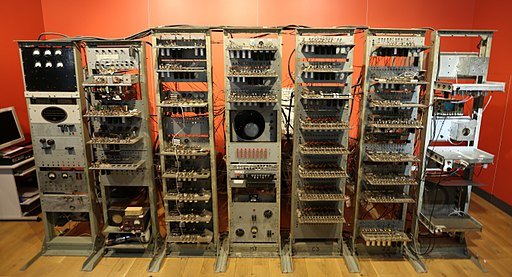
The Manchester 👶 (sleeping 💤)
Its new features were the capability of storing programming instructions into electronic memory (he has got a kind of RAM) and, even more important, there were no scattered wires and was easier to programme.
The last steps that led humanity to build the computers we know today are the invention of transistors, integrated circuits and other major improvements.
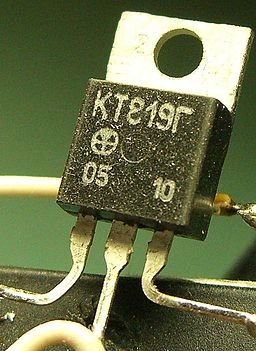
A bipolar junction transistor
Transistors are very important because they totally replaced the vacuum tubes that were too bulky, energy inefficient and ugly. Today's computers also take advantage of resistors, capacitors, inductors and diodes.
Credits
The Ishango Bone... → Ben2
... and its "tally marks" → Wero
The Antikythera Mechanism → Marsyas
Antikythera Mechanism Computer Animation → The Antikythera Mechanism - 2D
The Analytical Engine → Bruno Barral (ByB)
A Computer-made recreation of a Polish Bomba 💣 → Unfogettable War
Colossus in Bletchley Park → Ian Petticrew
Colossus Control Panel → Ibonzer
ENIAC (Electronic Numerical Integrator and Computer) → TexasDex
The Manchester 👶 (sleeping 💤) → Geni
It is a very nice post, that actually remembers me a museum I visited in Palo Alto years ago (the computer history museum). I do not know if you have visited it.
In order to get more visibility at least on SteemSTEM, you should add a few references allowing the interested readers to access the sources that have been used to write this post. This is a kind of requirement for any stronger support from the project. Thanks in advance for your consideration.
Hello @lemouth , it's always nice to see you and I'm happy you liked the post!
I'm sorry I forgot to add references (I didn't know, I thought I just had to add the source of the copyrighted pictures), but it's always good to learn something new; next time I'll do it for sure.
About the museums, I love museums but I haven't been to that one in particular, unfortunately I don't travel much (and that's not my fault...), however I would like to see it one day, I'll remember.
I forgot, this post "series" is divided into three single posts, the next one is about the hardware (it was too long for a single post). I claimed in this post that I'll explain how computers work and who made them work in the first place, but I haven't did it yet, so I have some more time to add references to new posts!
Concerning the length, I personally won't change a thing. That is perfect and the posts reads itself easily. I am looking forward to the next episode then :)
Also note that you may want to be using the following syntax for the images,
to make the images visible on steemstem.io. Just pasting a link is in fact not fully compliant with markdown.
Thank you again, I hope I won't disappoint
Posted using Partiko Android
This is a very good history of early computers. I have been a computer geek since the mid 70s. Thank you for sharing this short history.
That's great; I admire people who know so much about computers! (Because I wasn't even born in the '70; but I knew "old school" PCs)
And thanks for your attention!
Posted using Partiko Android
Very interesting!
Resteemed.
Hi @zuerich , I'm happy you liked it 😁
Posted using Partiko Android
Questo post è stato condiviso e votato dal team di curatori di discovery-it.
This post was shared in the Curation Collective Discord community for curators, and upvoted and resteemed by the @c-squared community account after manual review.
@c-squared runs a community witness. Please consider using one of your witness votes on us here
I'm not sure that first image is a computer. An old microfilm viewer maybe?
Hello!
I just checked the image, its link is https://pixabay.com/photos/lost-places-factory-old-abandoned-1719531/ , I didn't find out if it is a computer or not, but I remember I typed "old computer" in the pixabay search box
It isn't a definitive answer anyway, maybe you want to check by yourself! 😉
Posted using Partiko Android
Congratulations @fral! You have completed the following achievement on the Steem blockchain and have been rewarded with new badge(s) :
You can view your badges on your Steem Board and compare to others on the Steem Ranking
If you no longer want to receive notifications, reply to this comment with the word
STOPVote for @Steemitboard as a witness to get one more award and increased upvotes!
This post has been voted on by the SteemSTEM curation team and voting trail. It is elligible for support from @curie.
If you appreciate the work we are doing, then consider supporting our witness stem.witness. Additional witness support to the curie witness would be appreciated as well.
For additional information please join us on the SteemSTEM discord and to get to know the rest of the community!
Please consider setting @steemstem as a beneficiary to your post to get a stronger support.
Please consider using the steemstem.io app to get a stronger support.
I want to know more about the tally marks and how it worked.
Also that mega calendar was pretty cool to read about.
Thanks for sharing! Keep steeming.
Hello!
The tally sticks are simple tools: primitive men used them as sheets of paper.
Imagine you are a primitive woman and you want to count how many primitive dresses you have in your primitive wardrobe, but you have so many of them that you can't keep the count just with your mind, so you need to write it somewhere, thus you take a bone and sharp stone, every time you take out a primitive dress from your primitive wardrobe you put a mark (!) with your stone on your bone (!), until you get all the dresses out the wardrobe; by doing this you got a representation of the number of your dresses on a stick, if you count all the marks you can easily get the number of the dresses.
Now your marks are "tally marks" and your bone is a "tally stick".
I hope the idea is clear.
If you want to know more about the mega calendar/clock, aka Antikiperra Mechanism, you can read the Derek De Solla Price ideas in his book "Gears from the Greeks: The Antikythera Mechanism--A Calendar Computer from CA. 80 B.C."
Thanks for being here!
Posted using Partiko Android
That is so simple it’s amazing.
Of course that’s all there is to a tally stick.
Thank you for taking the time to respond.
I’ll keep that other mechanism in mind...
Posted using Partiko iOS
Yes, it's simple but there are a lot of speculations. I think the best you can read is this book (https://books.google.it/books?id=2f1aDgAAQBAJ&pg=PA35&redir_esc=y#v=onepage&q=ishango&f=false) and the Wikipedia page (https://en.wikipedia.org/wiki/Ishango_bone)
(I wanted to answer earlier but I hadn't got much time 😅)
Posted using Partiko Android
One thing to note in a great summary like this is how innovation is increasing at an exponential rate - the time between each advancement is getting shorter than ever before and the advancements are larger than before in many cases.
I built my first computer from scratch in 1978 and my watch now has orders of magnitude more capabilities for a tenth the cost with inflation factored in.
I know what you mean.
These are the marvels and pardoxes of technical improvement and research
I have some old computers alone in a room that I trying to resurrect, I want to make a cluster and then a personal server, but every time I try to install an OS there's a problem, last time it was a broken drive. Nowadays, it's very difficult to use old things with the new ones
Posted using Partiko Android